Let’s talk about how to grow and use valerian. Valerian, a prolific perrenial herb sometimes referred to as “garden heliotrope”, may be the sweetest smelling herb you can grow, at times that is. The true beauty, however, of this flowering herb rests in its roots.
This post may contain affiliate links at no additional cost to you. By making your purchases through the links on this website, IMSL may make a small percentage at no direct cost to you. IMSL only promotes products we use & truly believe in. Please refer to my Privacy & Disclosures for further information. IMSL thanks you for your support!
A favorite for both the ornamental gardener and for its use in kitchen witchery, learning to grow and use valerian is not difficult. By learning to grow your own valerian you are ensured of a steady supply of this herbs powerful root.
WHAT IS VALERIAN
Valerian, Valeriana officinalis, is a hardy perrenial herb, native to Eurasia, which grows prolifically. It’s name derived from the Latin “valere” translates as “strong” or “to be healthy”. This herb has been grown & used for centuries for both its beauty in ornamental gardening as well as in home apothocaries.
With its sweet, vanilla scented blossoms, and roots with a scent that is often likened to “dirty socks”, this powerful herb has earned its place in both our gardens & our herbal cabinets. Used throughout history for some interesting uses, valerian today is still recognized largely for its calming properties.
VALERIANS FOLKLORE
Valerian, has been re-nowned throughout history for a multitude of uses, remedies, and preventions. Ancient Greeks would hang this herb in their homes & windows to ward off evil spirits, and Celts would do the same to keep lightening at bay.
This herb was used in magics as an addition to love potions & sleep pillows, believed to be an aphrodisiac, & worn by woman to attract men. This herb is generally regarded as a feminine element (corresponding to the natural, physical world) & its power consisting of love, purification, sleep, & protection.
In the Middle Ages, valerian was prescribed to treat epilepsy and is still widely used in Chinese medicine today for just that.
Widely referred to as a “poor man’s valium“, and “the perfect herbal tranquilizer”, valerian was used more recently during the First World War to treat shell-shock amongst soldiers. Londoners used it for sleep issues during World War II, and in more recent times is being used for improving sleep, nervousness, anxiety, cramps, and headaches as well.
HOW TO GROW VALERIAN
This tough herb is grown best in full sun to light shade in gardening zones 4-7, but have also heard of successful growing up to zone 9. This herb will rise to a height of 3-5 feet tall, therefore makes a wonderful addition to ornamental gardens as a backdrop if you’re not interested in harvesting its roots.
If you are looking to harvest the roots, be sure to place this herb in a location conducive to doing so. Here on the hill, we’ve placed our valerian on a sloping area that is not maintained but only several times a year. We allow it to self-seed and spread, in essence, containing it to one area. We can harvest the roots as needed without disturbing our more formal garden beds.
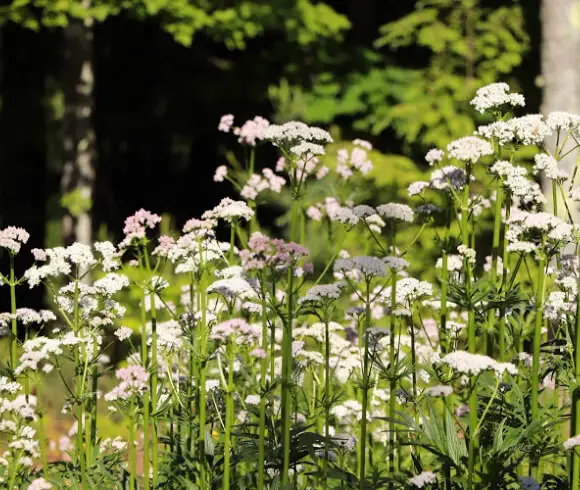
VALERIAN GROWING PRECAUTIONS
Ornamental gardeners beware! Valerian self-seeds prolifically unless deadheaded before the flowers can set seed. Take it from experience. Unless you want valerian popping up throughout your entire garden, remove those flowers!
Even with dead-heading, be prepared to find valerian shoots popping up all around your yard. Wind freely distributes any missed seeds, birds transplant this herb easily, and it can easily take over garden spaces in the blink of an eye.
Our feline friends are often drawn to this herb and love the roots. Should they get a whiff of the root, you can surely kiss the rest of the plant goodbye as they will roll over the plant until it’s completely decimated!
VALERIAN GROWING CONDITIONS
This easy going, hardy herb grows in just about any type of well-draining soil. We literally took flower heads and threw them over this sloped area 3 years ago in the picture above. You can see how they’ve self-sown and spread. They receive no special care, the soil is rocky and gravelly, and still they grow.
No garden space to let them grow? Valerian can be grown in pots with a few precautions taken. Making sure that the pot is large enough for a robust root growth and watering to prevent drying out will create success with container gardening this herb.
VALERIAN PROPOGATION
To sow valerian, you have several options. The seeds can be sown directly into the garden area after threat of frost, or they can be started indoors & later transplanted into your gardening space.
VALERIAN MAINTENANCE
Our ideal growing location as stated in un-maintained. The herbs get no additional watering or care other than what nature provides. But here on the hill our growing methods tend to be “live or die” 🙂
Valerian requires moderate to heavy watering and does not like drying out. It’s best grown in well-drained, moist loamy soil, in full to part sun for optimal results.
BREAKING DOWN VALERIAN PLANT
As stated, the valerian can grow to almost 5+ feet in the right conditions. The plant itself consists of a single stalk, that is hollow in the center.
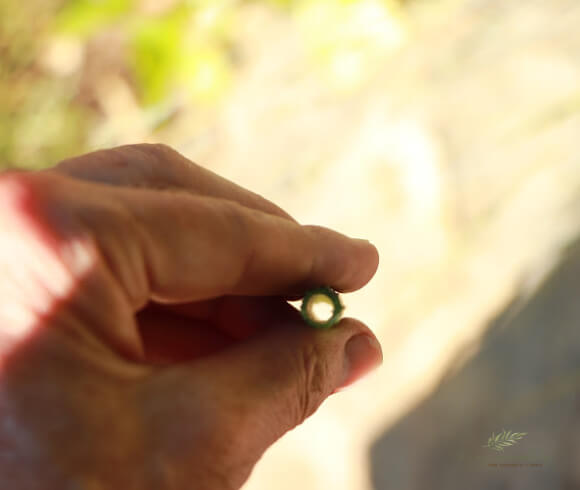
Off the single stalk, valerian has opposite compound leaves with seven to ten plus leaflet pairs.
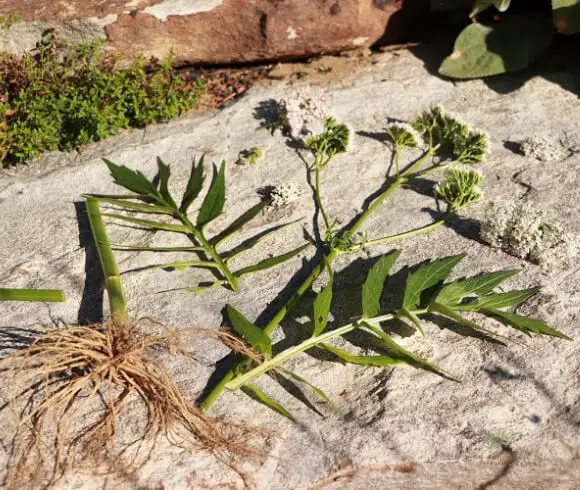
The valerian bloom, growing at the top of the stalk, typically starts out as a light, blush pink color, & quickly transforms into full white delicate blossoms that carry a heady scent of vanilla.
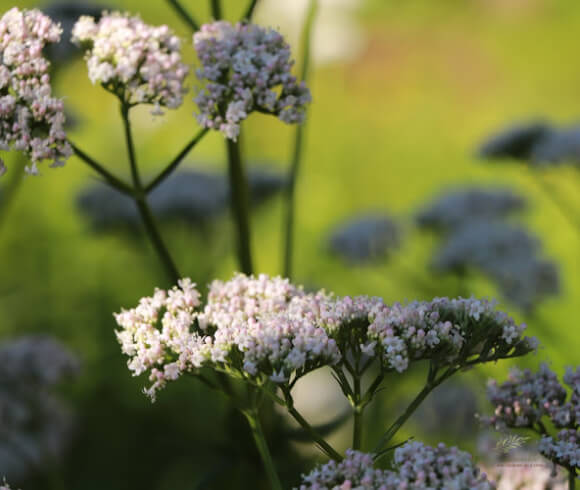
HARVESTING VALERIAN
To harvest your valerian for its roots, you have options. Ideally, valerian root should not be harvested until the plant is at least two years old when using for its medicinal properties.
To harvest valerian root, wait for a good rain or water deeply prior to digging up. This will help loosen the soil and allow for the excavation of the root in full.
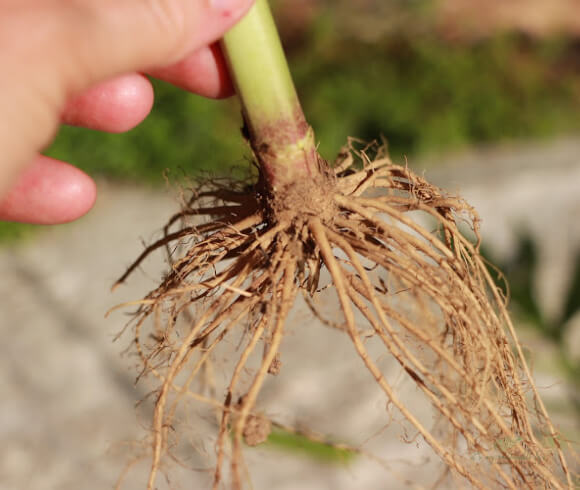
As you can see from the above picture, valerians root system is long & spindly, hairlike. Cleaning thoroughly to remove any dirt & debris can be a chore to say the least. Having a bucket of clean water to swish the roots around in aids in the cleaning process. This will need to be done several times for a complete wash.
Once completely clean, the root is now ready to dry.
Don’t forget to save a bit of the flower, chopped leaves, and chopped stems as well to dry and use in tea or tincture!
DRYING VALERIAN
To dry your harvested root & plant parts you have several options. Air drying, check out our tutorials “13 Ways To Preserve Fresh Herbs” as well as “Beautiful Basil! How To Dry & Store” for some drying inspiration! Our favorite method by far for drying any herb is air-drying. However, many who live in excessive humidity may find this method difficult. Air drying can take at least 2 weeks or more.
You can also opt to dry your herb in the oven. To oven dry, place your cleaned & patted dry herb & root in the oven at 200 F. Leave the oven door slightly ajar and check the valerian every 15 minutes until dried. You know when they are fully dried when the root & herb is brittle & dark in color.

Utilizing a dehydrator is another option for drying your valerian. Every dehydrator comes with specific instructions, so first refer to your directions. Should your dehydrator have the option to adjust the temperature, set it at 100 F on low & dry checking every few hours. Typically, it will take only 3-4 hours to dry fully depending the the thickness of the root.
Dryer beware! This is the stinky part of drying your valerian root. Plan on completing the drying process on a day where you can open up some windows or your house will smell like dirty socks 🙂 Alternatively, if using a dehydrator, consider drying the herb in the garage or basement.
HOW TO STORE DRIED VALERIAN
We highly recommend storing your dried valerian root in a different container as the stem and leaf. Depending on what you will be using it for, & your tolerance levels will determine which part of the plant you will be utilizing, you will easy access to either.
Once you have dried your roots and plant parts, you now have options for storing depending on how you will be using the herb. Here on the hill, we prefer to chop the root and crush the plant parts and store in sealed containers for storage in a dark cupboard.
However, many may want to leave whole (use to be determined at a later date), chopped (for decoctions & infusions), or powdered (filling capsules). The choice is yours.
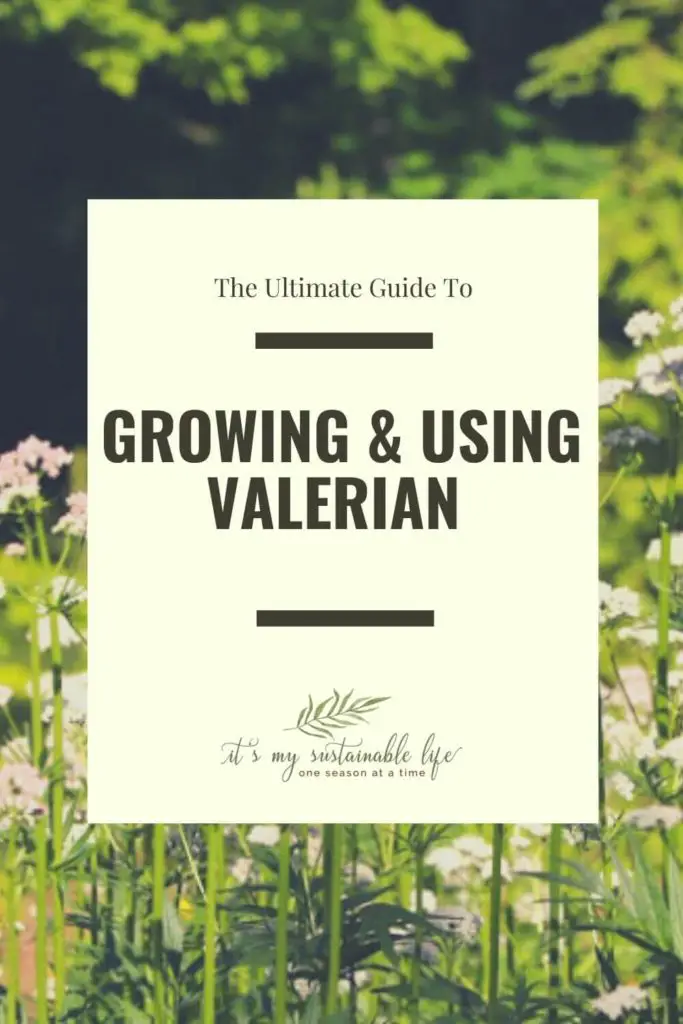
HOW TO USE VALERIAN
When most think of valerian the first thing that comes to mind is sleep. Known for its calming effects and inducing a deep, restorative sleep, valerian has been widely used as a non-addictive sleep-aid.
However, valerian benefits don’t stop at a good nights rest. This herb is considered and known as a nervine (something used to calm the nerves), hypnotic (used to induce sleep), a nervous system tonic (something used to calm the nervous system), a sedative, a stomachic (something used to aid digestion), an expectorant (something used to promote the secretion of sputum by the air passages), an anodyne (painkiller), and a muscle relaxant.
A few ailments that valerian has been know to treat are…
- Stress Remedy
- Sleep Aid
- Anxiety
- Insomnia
- Nervous System Aid
- Digestive Issues
- Strong/Natural Sedative
- Pain Reliever
- Headaches
- Treat Pets For Anxiousness/Nervousness
WAYS TO USE VALERIAN
There are a few options of how to use valerian. Most are easy to make and have on hand when needed. Some have a longer shelf-life than others, & therefore, in our humble opinion are best to make.
VALERIAN INFUSIONS & DECOCTIONS
Probably the easiest way to use the dried root of the valerian plant is to make an herbal infusion (click for directions). To make a decoction (a very strong infusion), simply simmer the infusion until reduced by half. Sip the brew as needed.
If you are in need of a milder form of valerian “tea”, save and dry some of the leaves and stems as well. Add a bit of both along with a touch of the root to create a soothing tea. When using dried herb add 2 tsp, fresh herb add 5 tsp to 4 cups water. Bring to a boil, shut the heat off, and let steep for at least 30 minutes. Enjoy before going to bed.
TINCTURES
Tincturing is our favorite method of utilizing valerian root. This method touts a long-lasting shelf-life and when taken, absorbs quickly into the blood stream. A simple tutorial on how to tincture can be found here.
Brandy can be substituted for vodka, however, you will want to make sure it’s high in alcohol volume (80 to 100 proof).

For those wanting to make an alcohol free tincture, use glycerin. Use an organic vegetable glycerin (75% glycerin/25% distilled water) to make the tincture. Known as “glycerites” (glycerin based tincture) they will have a shortened shelf life than that of alcohol based tinctures.
“A glycerite has a shelf life of 14-24 months, versus an alcohol extract with a shelf life of 4-6 years.”
Mountain rose Herbs
We typically utilize vodka for the making of our tinctures. A quick note, however, for those dealing with food allergies & intolerances. Read & research your alcohol sourcing & note where it is made (origin), and from what it is made.
As with much of our food sourcing here in the US, grain is largely GMO’d. As a large portion of vodka is no longer made strictly from potato, as in the past, but instead from grain, knowing the source of your alcohol can make a huge difference in preventing any un-wanted allergic reactions.
We highly recommend purchasing vodka made organically or sourced from countries who have banned the use of GMO’s such as Sweden.
Valerian tincture can be taken orally (under the tongue if you can tolerate it) or added to a bit of water to drink.
VALERIAN OINTMENT
Typically salves & ointments, such as our “Dandelion Salve And Its Many Uses” are made to treat skin issues, sore muscles, and joint pain. By simply changing this recipe to include 1/2 dandelion oil and 1/2 valerian oil would be an amazing option for additional relief with sore muscles & joint pain.
Creating a complete valerian ointment by first infusing valerian into oil (see how to infuse oil here) and then made into a salve to be rubbed on the bottom of feet makes a wonderful relaxant to induce sleep. Simply follow the Dandelion Salve recipe & substitute valerian oil when making.
VALERIAN BATH & FOOT SOAK
Many are now once again realizing the huge benefits of soaking feet & taking baths. They can soothe tired, sore muscles, & even improve hydration.
To make a simple valerian bath soak, take the root, place into an old sock or pantyhose and place into the warm bath to steep.
To create an easy valerian foot soak with an added benefit of some reflexology (known to improve circulation, stimulate muscles, reduce tension, and ease pain), add marbles to the bottom of your foot soaking vessel. Fill with as warm water as you can stand, add your valerian in the same manner as the bath soak, sink your feet in, sit back and relax.
CAPSULES
Valerian can be taken orally through capsules as well. These can be purchased or made. If you grow your own (highly recommend this as the herb will be the freshest you can possible acquire), to make capsules harvest your root (stem and leaf may be used in addition to the root), dry, grind to powder form and fill capsules to your desired strength.
VALERIAN COMPRESSES
Herbal compresses are commonly used in Thai medicine. These hot herbal compresses soothe aching joints, relax & energize overworked muscles, & relieve chronic pain from overuse injuries.
To make a valerian herbal compress, simply use the decoction or infusion method as stated above, soak a clean piece of material or cotton in the decoction, & place on the affected area. Wrap to secure if needed.
VALERIAN IN ANIMAL USE
Valerian has been used in the equestrian world to treat anxiousness, nervousness, moody mares (as a decoction), and as a salve to treat bruising and muscle soreness. Dogs and cats alike are not left out of utilizing valerians benefits either.
If you are interested in utilizing valerian for your animals, be sure to follow a few guidelines, do your due diligence and research further dosages, uses, and cautions. A few to be aware of are…
- LOW DOSAGES – Always begin by using the lowest dosage possible for any animal and work up from there.
- PREGNANCY CAUTION – Avoid using valerian on any pregnant or nursing animal
- SHOW ANIMALS – Valerian has been banned on some equestrian competition show lists. Avoid use if you are competiting on a level that your horse will be tested.
- VETERINARIAN – Check with your veterinarian prior to giving valerian to your animal.
Many other methods for using valerian are available in addition to those listed above. Valerian use in the cosmetic industry in perfumes of all things, as well as in culinary uses (during the Middle Ages valerian was added to soups & stews, its young leaves eaten early spring, and its dried root was ground into a flour).
Personally, we have never heard of anyone utilizing this plant as a food option, but always good to know in case of emergency 🙂 It is rather nutritious, containing high quantities of calcium, selenium, tin, aluminum, chromium, iron, and magnesium!
IS VALERIAN SAFE TO USE
As with any of natures potent herbs & plants, valerian does come with a few cautions & guidelines to be followed. As with most herbs, valerian should not be taken for more than two weeks at a time. Take a two week break, give your body a rest from the herb, and then resume if needed. Continued use may cause depression and headaches in some.
Refrain from using valerian is you are pregnant or nursing (same with animals), do not give to small children, and if you are over 65 years of age start out with small dosages only.
In a rare few, valerian may cause headache, sluggishness, mental foggyness, excitability, unease, and heart disturbances.
Also good to note that valerian in some may act in the exact opposite way as for most when it comes to sleeping. For some, about 5-7% of people, valerian can cause insomnia, agitation, giddiness, and restlessness. Give valerian a go during the daylight hours when you have some down time when first trying it, see what your reaction is!
For many, vivid dreams or nightmares may occur from taking valerian.
Taking herbal supplements is typically safe for most. A level of commonsense is needed when beginning any new herbal regime, and discontinue use if you are not feeling an overall sense of calmness and relaxation when taking the proper dose of valerian.
**A quick notation, we are not doctors here on the hill. We enjoy sharing & educating on natural remedies that can benefit many as they have for us. Always use commonsense, do your due diligence & research, & consult with your primary care physician prior to beginning any herbal routine. This information is not intended to be used as medical advice & is strictly for entertainment purposes only. If you have any questions, refer to our Privacy & Disclosures.
HOW TO GET RID OF VALERIAN IN THE GARDEN
Not to beat a dead horse, but valerian can become invasive. Can you get rid of valerian? Yes. Does it take some work to do so? Yes.
Forewarned, forearmed, the best method of removal is prevention. As stated, by deadheading the flowerheads before they go to seed will save a LOT of headaches later on. Trust us. We know from experience having to “weed” valerian volunteer plants from all over the garden.
The best and safest method of removing valerian completely from your gardening spaces is to pull or dig up by hand. IMSL does not condone or promote the use of chemicals for any garden issues. Mowing, cutting, & pulling are your best friends when trying to get rid of this abundant herb.
Do you presently grow & use valerian? Join in the conversation below and share your thoughts, tips, and experiences with valerian. In addition, IMSL would love for you to follow us on social media by clicking on the icons below.
Love, Light, & Laughter ~


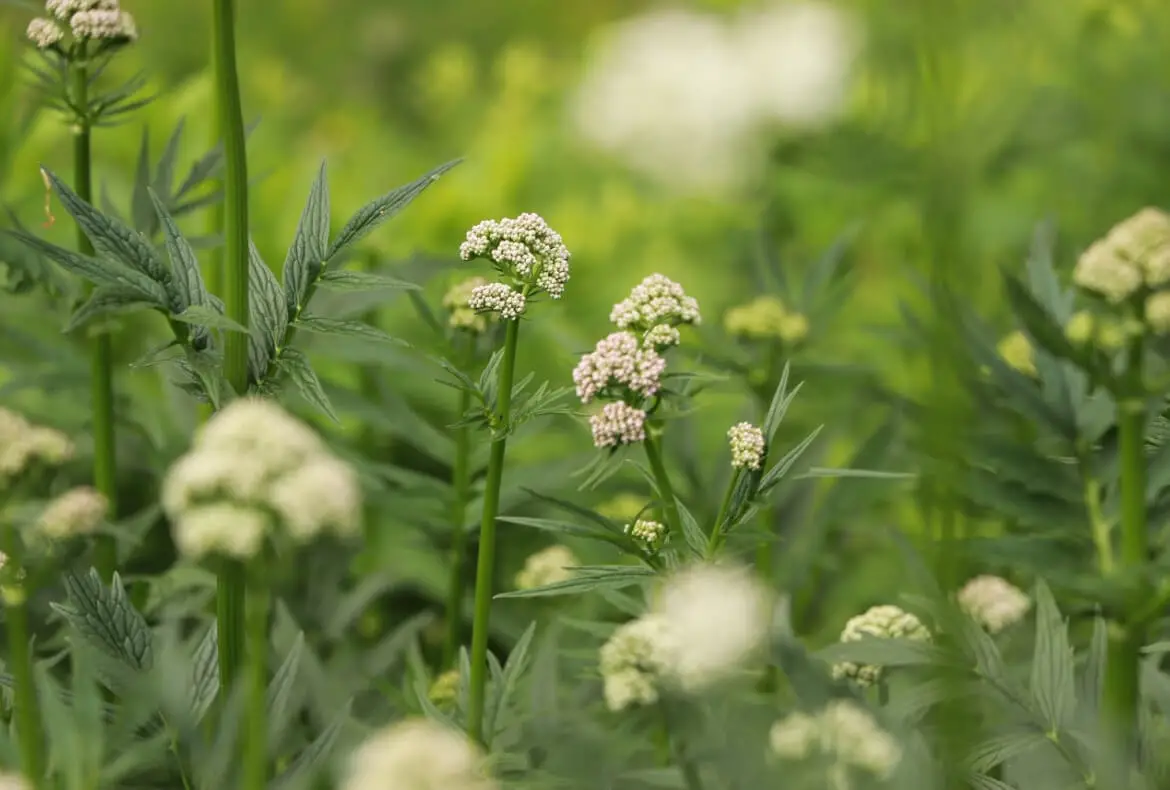
28 comments
I was introduced to Valerian in northern Maine where it grows very well. However, I was more interested in its scent than its medicinal qualities. I think if Heaven had a scent it would be this flower. Women used to wear it for perfume.
Have you any knowledge of anyone who makes a perfume or how to make it yourself?
I have not made my own perfume. I would think you could capture it’s scent somewhat by creating a hydrosol from the fresh plant & using that as a body mist, light perfume. It would be an interesting experiment! Let me know if you come across another way to harness the beautiful scent of the valerian flower…its is gorgeous!
Great post! I particularly enjoyed the folklore!
I love learning about plants when I read your posts. I’m getting such a great education. Thanks for sharing!
I’ve never tried growing this herb! Sounds like I’d best avoid it though. I already fight to contain several other prolific herbs and ornamental grasses!
I’ve never heard of it but its pretty and it looks like it can help mitigate lots of issues.
When I officially have an herb garden it sounds like I’ll need Valerian! A big plus is keeping the mousers off of the deck.😂
This is so informative. Thanks for sharing.
I have never heard of this plant but it sounds like it has a lot of good uses.
Wow, this is very interesting and informative. I think it is pretty as well!
I have heard about Valerian before but I didn’t know the benefits. Such a great info, tips and ideas about this powerful herbs.
I never saw a plant with a hollow stem. Interesting!
I never knew valerian had so many great uses.
Wow, this is a super helpful post! I knew Valerian root was an awesome herb to have but you really nailed the info here! Thanks!
I’ve never grown valerian before. Thank you so much for the information and tips, I may be growing some in pots this season!
Thank you for enlightening me. I had never known about this until your writing about it.
Very informative! This grew wild all over my grandparents mountain property but I never knew what it was.
I’ve heard of Valerian before but it never occurred to me to grow my own – I’ll have to give it a try!
All new to me! I’ve always grown culinary herbs, and love it. I use melatonin for sleep issues; I may need to check out valerian. Thanks!
I’ve used it before for sleep and you’re right – dirty socks is a good description. I diffuse it with lavender because the lavender smells soooo much better!
We love to garden and try new things. I have Valerian essential oil but would love to try to grow my own. Looks very doable.
Oh you had me right up until the warning about self-seeding. I have a small yard with small gardens. I think I’ll hold off on Valarian. It is pretty though and it has so many wonderful uses.
A fascinating read. I have heard of Valerian before, capsules for sleep etc. But this is a great herb (okay maybe not the dirty-sock-smelling roots) but all the other information was really interesting. Thanks!
LOL! You got that right! Enjoy!!
I’ve only every taken Valerian as a natural sleep aid – so it was in a capsule. But now I’m intrigued – I wonder if it would grow here in the far north? I can grow other herbs such as basil, cilantro and parsley and sage quite well here during our six weeks of summer and 20+ hour day light. Maybe I’ll give it a shot! Found you on the Homestead Blog Hop #294.
Hi Sarita~
Thanks so much for stopping in! I’m not sure of your gardening zone, but valerian can grow in zones 4-9. Maybe start yours indoors to give it a head start. Hope you can give it a try!
I’ve grown Valerian in the past… and it is wonderful. I used it not for sleep, but to relieve my fear of public speaking when I had to give presentations at work. If I failed to use it (as a tea), my presentations were lame. If I used it – this worked wonderfully.. I also used several cups of tea before having surgery to remove a glob of “whatever” out of my eye. I was able to calm down enough that I didn’t need full anesthetic. Which saved me from medical out of pocket expenses. (I have an eye phobia stemming from an operation back when I was five or six years old). Valerian is a good resource to have around.
It is a wonderful calming agent for all types of purposes! Thank you for your thoughts & happy to hear valerian works for you!